Election. Recession. No landing. Social unrest. Election contest.
Low beta, anyone?
Today we’ll talk calm in a sea of manic. A six-pack of tranquil dividend payers yielding up to 8.9%.
How do we know they’re tranquil? Beta, baby.
A stock with a beta above 1 is considered more volatile than “the market.”
A stock with a beta below 1 is considered less volatile.
Let’s say a stock had a beta of 0.5. This means it’s half as volatile as the market. If a 30% bear market swipes, this safety stock only loses 15%.
It’s an inexact science—I wouldn’t build projections per se around current beta.… Read more


Recent Comments